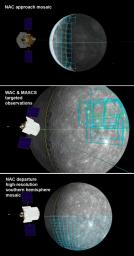On Target for Mercury Flyby 3 - Two Weeks To Go!
Caption:
Two weeks from today, the MESSENGER spacecraft will pass 228 kilometer (142 miles) above Mercury's surface for the mission's
mission's third flyby
of the Solar System's innermost planet. The MESSENGER team has been working on the flyby observation plans for months. Three of the highlights for MDIS include:
-
NAC approach mosaic. This mosaic will provide the first close-up images of a portion of Mercury's surface by spacecraft. (That portion of the surface appears as a featureless white strip near the limb of the planet in the top image.)
-
WAC and MASCS targeted observations. Unlike the neatly arranged rows and columns of most MDIS mosaics, for these observations WAC images in 11 color filters will be acquired as MASCS collects high-quality spectral measurements of specific targets of interest.
Visit this page
to learn more about these targeted observations.
-
NAC departure high-resolution southern hemisphere mosaic. This large 15-column by 13-row mosaic will provide new detail for an area of Mercury's surface in the southern hemisphere and will be complementary to a
high-resolution mosaic
of the northern hemisphere obtained during Mercury flyby 2
Date Acquired:
September 29, 2009
Instrument:
Narrow Angle Camera (NAC) and Wide Angle Camera (WAC) of the Mercury
Scale:
Mercury's diameter is 4880 kilometers (3030 miles)
Background Info:
These images are from MESSENGER, a NASA Discovery mission to conduct the first orbital study of the innermost planet, Mercury. For information regarding the use of images, see the MESSENGER
image use policy
.
Cataloging Keywords:
| Name |
Value |
Additional Values |
| Target |
Mercury |
|
| System |
|
|
| Target Type |
Planet |
|
| Mission |
MESSENGER |
|
| Instrument Host |
MESSENGER |
|
| Host Type |
Orbiter |
|
| Instrument |
Mercury Dual Imaging System (MDIS) |
|
| Detector |
|
Narrow Angle Camera (NAC), Wide Angle Camera (WAC) |
| Extra Keywords |
Color |
| Acquisition Date |
|
| Release Date |
2009-09-15 |
| Date in Caption |
2009-09-29 |
|
| Image Credit |
NASA/Johns Hopkins University Applied Physics Laboratory/Carnegie Institution of Washington |
| Source |
photojournal.jpl.nasa.gov/catalog/PIA12212 |
| Identifier |
PIA12212 |

 Planetary Data System
Planetary Data System
